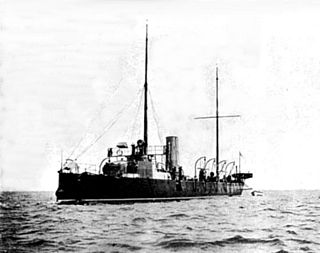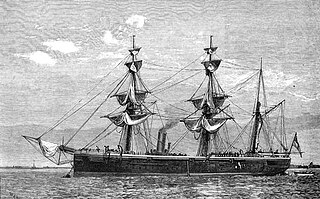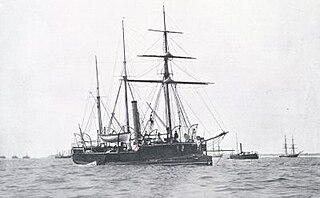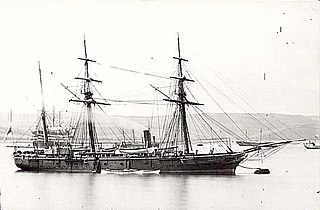
The Osprey class was a Royal Navy class of screw-driven sloops built between 1874 and 1877. Nine additional ships were built to a revised design, the Doterel-class sloop. They were the first class of ship in the Royal Navy to use glass scuttles.

The Mariner class was a class of six 8-gun gunvessels built for the Royal Navy between 1883 and 1888. Four were built in the Naval Dockard at Devonport, and two elsewhere; the Acorn was built by contract at Jacobs Pill on the Pembroke River, while the Melita was built in the Malta Dockyard, the only substantial ship of the Royal Navy ever to be built in the island.

The Redbreast class comprised nine first-class screw-driven composite gunboats built for the Royal Navy in 1889, mounting six guns.
HMS Viper was an armoured iron gunboat, the only ship of her class, and the fourteenth ship of the Royal Navy to bear the name.

The Dryad-class torpedo gunboat was the last class of torpedo gunboat built for the Royal Navy. This type of vessel was rapidly replaced by the faster torpedo boat destroyer, and all of the class were converted to minesweepers during World War I, with the exception of Hazard, which became a submarine depot ship.

HMS Rattlesnake was a unique design of torpedo gunboat of the Royal Navy. A result of the Russian war scare of 1885, she was designed by Nathaniel Barnaby that year and built by Laird Brothers, of Birkenhead. Quickly made obsolete by the new torpedo boat destroyers, she became an experimental submarine target ship in 1906, and was sold in 1910.

HMS Wasp was a Banterer-class composite screw gunboat of the Royal Navy, built in 1880 by Barrow Iron Shipbuilding and wrecked off Tory Island in 1884.

The Doterel class was a Royal Navy class of screw-driven sloops. They were of composite construction, with wooden hulls over an iron frame. They were a revised version of an 1874 design by the Royal Navy's Chief Constructor, William Henry White, the Osprey-class sloop. Two of the class were lost, one to an explosion off Chile and one wrecked off Canada. Gannet is preserved at Chatham Historic Dockyard.

The Ant-class gunboat was a class of twenty-four Royal Navy flat-iron gunboats mounting a single 10-inch gun, built between 1870 and 1880. They carried no masts or sails, being among the first Royal Navy vessels not to do so. The last four vessels were ordered separately and are sometimes known as the Gadfly class, although they were essentially identical. Members of the class lingered on as steam lighters, dredgers, boom defence vessels and base ships, lasting in some cases into the 1950s.

The Sharpshooter-class torpedo gunboat was a class of torpedo gunboat built for the Royal Navy in the late 19th century. One of the class was hulked in 1904, seven were scrapped before World War I and five were converted to minesweepers. Of these minesweepers, Seagull was lost to a collision in 1918 and the rest survived the war to be broken up in the early 1920s.

HMS Raven was a Banterer-class gunboat of the Royal Navy, built by Samuda Brothers of Poplar, London, and launched on 18 May 1882. She served on the Australia Station and was converted to a diving tender in 1904. After being lent as a training ship in 1913 she was sold for breaking in 1925.

The Ariel-class gunboat was a class of nine 4-gun composite gunboats built for the Royal Navy between 1871 and 1873. Although most were sold by 1890, one of them survived into the 1920s as a salvage vessel in private ownership. They were the first class of Royal Navy gunboat built of composite construction, that is, with iron keel, stem and stern posts, and iron framing, but planked with wood.

The Medina-class gunboat was a class of 12 Royal Navy Rendel gunboats mounting three 6.3-inch guns, built between 1876 and 1877. Flat-iron gunboats were normally built without masts or rigging, but the Medinas carried a full barquentine rig. Their robust iron hulls meant that they lingered on as diving tenders, barges and lighters, with five of them working into the 1920s. The hull of Medway lies in shallow water in Bermuda and is visible on satellite imagery.

The Arab-class gunvessels were a pair of composite gunboats built for the Royal Navy in the mid-1870s.

The Banterer-class gunboat was a class of eleven gunboats mounting two 6-inch and two 4-inch guns, built for the Royal Navy between 1880 and 1892.

The Albacore-class gunboat, also known as "Crimean gunboat", was a class of 98 gunboats built for the Royal Navy in 1855 and 1856 for use in the 1853-1856 Crimean War. The design of the class, by W. H. Walker, was approved on 18 April 1855. The first vessels were ordered the same day, and 48 were on order by July; a second batch, which included Surly, were ordered in early October.

The Britomart-class gunboat was a class of sixteen gunboats built for the Royal Navy in 1859–1867.

The Forester-class gunboat was a class of 4-gun composite gunboats built for the Royal Navy between 1874 and 1877. Although half had been sold by 1890, the rest survived into the 20th century as coal hulks, base vessels and other secondary uses. Foxhound survived as a hulk on the Blackwall Reach of the Thames until 1975, when she was broken up. They were built of composite construction, that is, with iron keel, stem and stern posts, and iron framing, but planked with wood.

The Albacore-class gunboat was a class of three gunboats built for the Royal Navy in 1883. The name had already been used for a class of 98 gunboats built during the Great Armament of the Crimean War.

The Grasshopper-class torpedo gunboat was a class of torpedo gunboat built for the Royal Navy in the late 19th century. All three ships were scrapped before World War I.



















